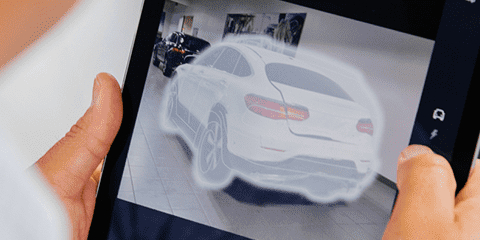By the Solera Insights team
The examination and calculation of vehicle claims has come a long way since insurers, assessors, and body shops first began manually evaluating damage and determining cost. A process that used to take days can now be completed entirely automatically by machines using artificial intelligence (AI) in just minutes. Or can it?
While it’s true that developments in deep learning and the power of computer vision technology – also known as visual intelligence (VI) – have enabled data scientists to build machine learning (ML) algorithms that can automatically detect vehicle damage and predict repair costs from photos, that doesn’t mean the human expert is rendered worthless in the process. In fact, the opposite is true: instead of replacing the human, the machine acts as a valuable assistant.
When used effectively, the unique combination of AI, ML, VI, and human intelligence creates a smarter, more productive system that prioritizes meaningful human contribution. A machine’s inherently indifferent and deterministic nature makes it ideal for taking over and helping automate simple, repetitive tasks. It also makes it ideal for bringing consistency to subjectivity-prone processes such as vehicle claims assessments.
When asked about where they saw the highest return by implementing digital tools (such as visual intelligence), insurers pointed to improved business resilience, faster decision making, and an increase in staff productivity, according to the Solera Innovation Index 2022.
Freed from more robotic tasks, the human expert can spend more time on work that creates value for the business and improves the customer experience. It is also both good practice and a necessity in the collision repair industry for AI and ML systems to include a human-in-the-loop component for interventional purposes. That’s because a machine’s greatest asset – consistency – also makes it blind to another important aspect of the vehicle claims process: nuance. Therefore, a hybrid approach is best.
An optimal hybrid approach accounts for the strengths and shortcomings of both humans and machines. For example, the machine uses computer vision to automate the damage capture process by working as the initial “eyes” and detecting parts and damages in the appraisal. It then combines the VI results with actual vehicle data and body-repair best practices to bring consistency to the estimating process while removing its inherent subjectivity.
Once the machine generates the claim data, the human expert then reviews it for things like misfires and contextual nuances or exceptions and subsequently makes corrections, acting as a sort of failsafe. The machine learns from this experience and the process repeats. Over time, more and more vehicle claims are automated, giving the human expert additional time to spend on more complicated claims or other valuable business items.
Mastering the right blend of AI, vehicle repair data, and human expertise is the key to producing accurate estimates consistently, efficiently, and effectively. Intelligent estimating solutions like Qapter that master all these domains are the best positioned to deliver the truest value through photo-estimating solutions.
Find out more about Qapter: https://www.solera.com/solutions/vehicle-claims/qapter/


